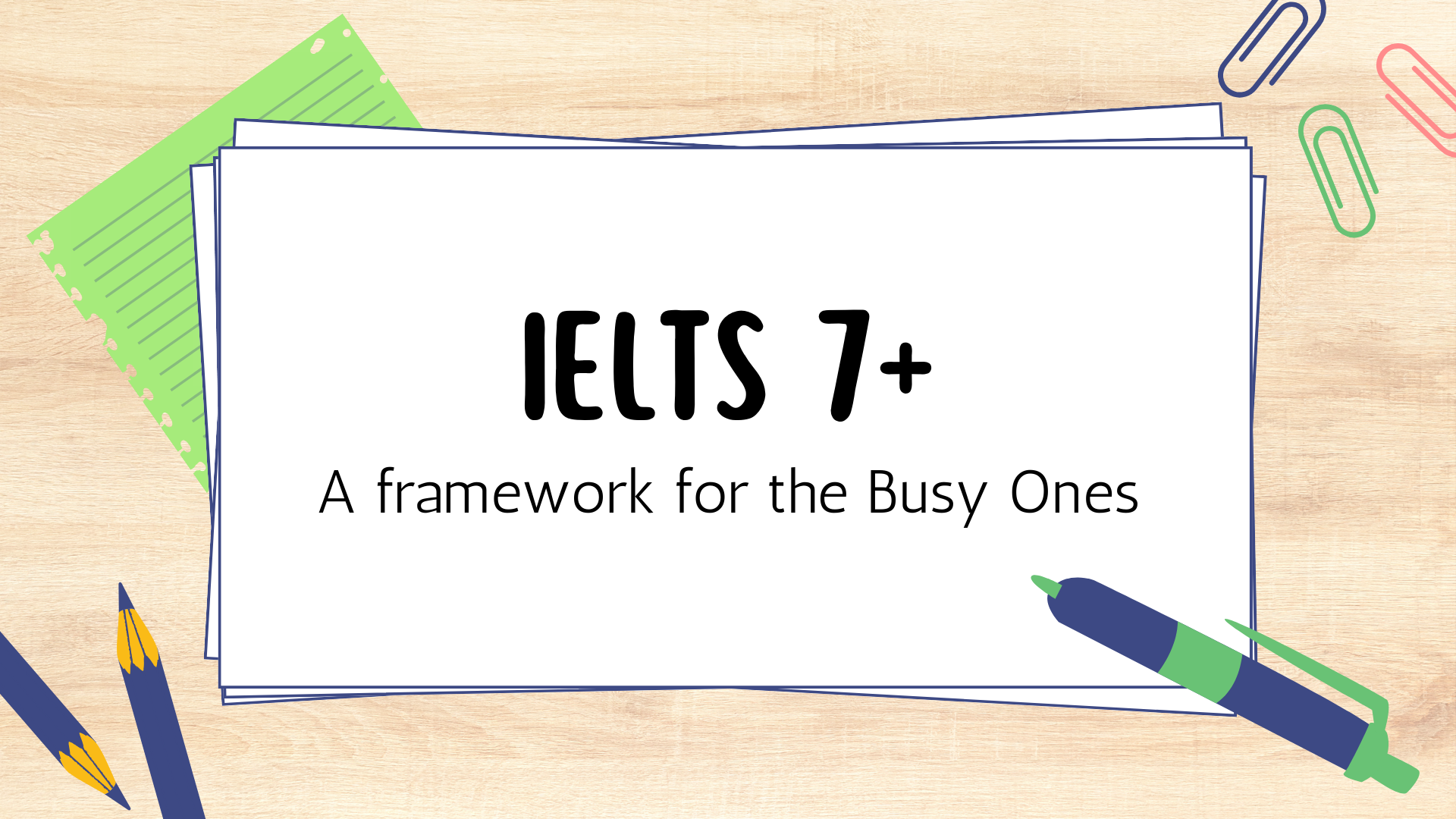Efficient Strategies: A Framework for Achieving IELTS Band 7+ for Busy Individuals
 Shams Nahid
Shams Nahid
Preparing for the IELTS exam requires dedication and a strategic approach. In this guide, we will outline a month-long plan, including daily practice, the use of Cambridge books, and computer-based exam strategies. Additionally, we'll provide a solid framework for tackling each section of the test.
This will require,
1 month of your efforts (A few hours a day)
Practices a few Cambridge books (at least the latest 5 ones)
Few practices of computer-based exams
For reading and listening use the online free tools
For speaking, listen to the records and also utilize speech-to-text free tools
For writing, use chat-gpt to get an estimated score and feedback
A rock-solid framework/blueprint (I am providing one in this article)
Computer vs Paper
This is one of the very common arguments between computer-based vs paper-based exams. I prefer the former one and let me tell you the reason.
I did the exam on a computer-based and this is a very personal opinion. Advantages I find,
Completed the writing in under 50 minutes (!)
Find quality times in reading, as I did not have to back and forth between the passage and questionnaires
Clear indications of how much time left
Clear indications of leftover questions
Word counts in the writing section
Listening
Create an expectation: For every single MCQ, Maps, Fill in the blanks, make sure there is some word(s) you are waiting to hear.
Create a few breakpoints: Create some hooks beforehand, so even if you missed a few questions, you can catch the speech in the next breakpoints from there. This means if you are listening to question number 5, then keep the question number 10 in your head. In case you missed all the questions 5, 6, 7, 8, and 9 when the number 10 comes, you could have started from there.
Forget the past: Once a question is passed, forget it. Don't try to fix it or even think of it. It will ruin the next questions. You will always get some time at the very end of the test to take a look.
Always look forward: Every time, you are asked to review the previous sections, don't do it. Move to the next section and try to create the expectation.
Reading
Limited time maintenance: Separate the timing for all 3 passages. It should be 17 minutes, 18 minutes, and 25 minutes respectively for the first, second, and third passages. Usually, the third one is the biggest and most challenging one. Try to cover all the questions within the time limit and in case of timeout, leave and move forward to the next passage.
Memorize questions pattern: Some answers come in a serial from the passage and some do not. Those who maintain the sequence, make sure, you read 2/3 in advance while scanning the passage. For example, when solving the true/false, always look for at least 2/3 upcoming questions. In case you missed the first and second one, there is a good probability that you will find the 3rd one. Then reverse a few lines and get the first two. For those questions, where the sequence is not maintained like matching headings or paragraphs, after every few minutes interval, try to read them all. Keeping them in your head while scanning the passage, will make them more visible.
Highlighting: Try to highlight all the probable words in the passage so this will help later resolve the not-answered questions.
Writing Task 1
Practice writing task 1 in 3 frameworks,
Chart (Line, bar, graph, double bar, double graph)
Map
Process
Idea Generation
Don't just dive into the writing. First of all, make sure, you have a clear and concise idea of what you are about to write.
Ask and observe the following questions to generate ideas before diving into the writing.
Charts
Highest/lowest values
Biggest increase and/or decrease
Biggest majority and/or minority
Stable data
Repeated values
Major trends
Notable exceptions
Maps
Residential changes
Countryside [more or less]
Infrastructure improvements [more or less]
Dramatic or negligible changes [overall]
Process
Starting and ending product (input and output)
Time for start and end
Man-made/natural
Circular or linear
Materials added during any stages
Each stage does
Relation between each stage
Now, you must know the key points of the questions.
Writing task 1 skeleton
It's time to start writing. There will be 4 sections of task 1,
Introduction (1 line)
Overview (2 lines)
Statistics section 1 (2 lines)
Statistics section 2 (2 lines)
Section 1: Introduction
Chart/Map: This report is derived from a bar chart that illustrates [specify_the_theme].
Two Graphs/Charts: The [first_chart] shows something while the [second_chart] shows something else.
Process: The diagram shows the process of [name_of_the_process]
Section 2: Overview
It is the most important part of the task 1. You have to find two important points here. Specify these two points and make sure you do not show any statistics here. In the, we will elaborate on the first point using the statistics. Also for the Statistics section 2, we will elaborate on the second point using statistics.
Chart: Overall, [specify_fitst_obvious_fact_of_chart]. Also, [specify_second_obvious_fact_of_chart].
Map: Over the period, the first major [developments/changes/transformation/reconstructions/modernization]. From year_one to year_two second major [developments/changes/transformation/reconstructions/modernization].
Process: Overall, this is a [man_made_or_natural] [circular_or_linear] process, consisting of [number_of_stages] stages, make [something] from [something]. Something special about one/more stage[s].
Section 3: Statistics section 1
Support the first line of the overview section. We can use 2 lines full of statistics.
Section 4: Statistics section 2:
Support the second line of the overview section. We can use 2 lines full of statistics.
Writing Task 2
Writing task 2 is the most wired fixed framework. Following the framework will make the task 2 lot less challenging.
Writing task 2 will have 4 sections,
Introduction [2 lines]
Body paragraph 1 [4 lines]
Body paragraph 2 [4 lines]
Conclusion [1 line]
Introduction
Line 1: Paraphrase the question
Line 2: State your position boldly with either agree/disagree or partially agree.
In any case, agree/disagree/partially agree, you must provide two contexts. For example,
In case of agree/disagree
Reason 1 of agree/disagree
Reason 2 of agree/disagree
In case of partial agree/disagree
Reason for partial agree
Reason for partial disagree
Body paragraph 1:
Line one: First logic for defending your first reason.
Line two: Example of first logic.
Line three: Second logic for defending your first reason.
Line four: Example of second logic.
An example of body paragraph 1,
[First of all/on one hand], *first_*logic. For instance, example_of_first_logic. To strengthen this view, *specify_*second_logic. To illustrate, we can see example_of_second_logic.
Body paragraph 2:
Line one: First logic for defending your second reason.
Line two: Example of first logic.
Line three: Second logic for defending your second reason.
Line four: Example of second logic.
An example of body paragraph 2,
[On the contrary/additionally], *first_*logic. To exemplify, example_of_first_logic. Moreover, *specify_*second_logic. To give a clear example, we can see example_of_second_logic.
Conclusion:
Again, say why you agree/disagree/partially agree.
Speaking
If you do not understand the verbal (not cue card) question of the examiner, you may ask for clarification. However, while doing the speaking exam, you can not ask a counter question to the examiner.
3 sections of speaking,
Initial QA
2 minutes of speaking
Interactive QA
Initial QA:
Answer affirmative for each question with 2/3 lines
2 minutes speak, the cue card
Speak one/two lines before going to the first query/question of the cue card
Stay under context for each query and answer them all in 1/2/3 lines
When you are done talking all these queries in the card, you have your freedom. Start talking shit (whatever you want) till you are stopped.
Cautions
1/2 line(s) should be strictly in the context (the question)
Consider present/past/future tense in the sentences
Consider first person or third person while telling a story or incident
Consider singular or plural numbers
Interactive QA
For each question, use 4-6 lines to answer
For first and second lines should be strictly to the question and later, you can say whatever you want (In case you do not find relevant answers).
Speak out of your mind, no one will judge you for your point
Do not stop unless you need to think about the context of the question
Final Words
By following this comprehensive guide, you can streamline your IELTS preparation, ensuring a well-rounded practice across all sections of the exam. Consistency, strategic planning, and a solid understanding of the provided framework will contribute to your success on test day. Good luck!
Subscribe to my newsletter
Read articles from Shams Nahid directly inside your inbox. Subscribe to the newsletter, and don't miss out.
Written by

Shams Nahid
Shams Nahid
A lifelong learner. Love to travel. Listen to music.